Chemistry > GCSE MARK SCHEME > GCE Chemistry A H432/01: Periodic table, elements and physical chemistry Advanced GCE Mark Scheme fo (All)
GCE Chemistry A H432/01: Periodic table, elements and physical chemistry Advanced GCE Mark Scheme for November 2020
Document Content and Description Below
GCE Chemistry A H432/01: Periodic table, elements and physical chemistry Advanced GCE Mark Scheme for November 2020 Oxford Cambridge and RSA Examinations GCE Chemistry A H432/01: Periodic table, e... lements and physical chemistry Advanced GCE Mark Scheme for November 2020Oxford Cambridge and RSA Examinations OCR (Oxford Cambridge and RSA) is a leading UK awarding body, providing a wide range of qualifications to meet the needs of candidates of all ages and abilities. OCR qualifications include AS/A Levels, Diplomas, GCSEs, Cambridge Nationals, Cambridge Technicals, Functional Skills, Key Skills, Entry Level qualifications, NVQs and vocational qualifications in areas such as IT, business, languages, teaching/training, administration and secretarial skills. It is also responsible for developing new specifications to meet national requirements and the needs of students and teachers. OCR is a not-for-profit organisation; any surplus made is invested back into the establishment to help towards the development of qualifications and support, which keep pace with the changing needs of today’s society. This mark scheme is published as an aid to teachers and students, to indicate the requirements of the examination. It shows the basis on which marks were awarded by examiners. It does not indicate the details of the discussions which took place at an examiners’ meeting before marking commenced. All examiners are instructed that alternative correct answers and unexpected approaches in candidates’ scripts must be given marks that fairly reflect the relevant knowledge and skills demonstrated. Mark schemes should be read in conjunction with the published question papers and the report on the examination. © OCR 2020Annotations Annotation Meaning Correct response Incorrect response Omission mark Benefit of doubt given Contradiction Rounding error Error in number of significant figures Error carried forward Level 1 Level 2 Level 3 Benefit of doubt not given Noted but no credit given Ignore Blank pageAbbreviations, annotations and conventions used in the detailed Mark Scheme (to include abbreviations and subject-specific conventions). Annotation Meaning DO NOT ALLOW Answers which are not worthy of credit IGNORE Statements which are irrelevant ALLOW Answers that can be accepted ( ) Words which are not essential to gain credit __ Underlined words must be present in answer to score a mark ECF Error carried forward AW Alternative wording ORA Or reverse argumentH432/01 Mark Scheme November 2020 5 SECTION A Question Answer Marks AO element Guidance 1 D 1 2.7 2 B 1 1.2 3 B 1 2.2 4 C 1 2.2 5 A 1 1.1 6 A 1 2.2 7 D 1 1.1 8 D 1 2.6 9 B 1 2.6 10 C 1 1.2 ALLOW 2 in the answer box 11 D 1 2.2 12 C 1 2.6 13 B 1 1.1 14 D 1 1.2 ALLOW 1 in the answer box 15 C 1 1.1 Total 15H432/01 Mark Scheme November 2020 SECTION B Question Answer Marks AO element Guidance 16 (a) (The mean/average mass) taking into account the relative abundancies of the isotopes 1 1.1 ALLOW sum of (isotopic mass × %abundance) sum of (isotopic mass × abundance) / total abundance DO NOT ALLOW average mass of the isotopes (i) 2+ – Mg Br – Br Mg with no (or 8) outer electrons AND 2 × Br with ‘dot-and-cross’ outer octet Correct charges 2 1.2 2.5 ALLOW 8 electrons in Mg2+ BUT ‘extra’ electron in Br– must match symbol for electrons in Mg2+ IGNORE inner shells and circles ALLOW 1 mark if both electron arrangements and charges are correct but only one Br is drawn. ALLOW 2[Br–], 2[Br]– (brackets not required) (ii) FIRST CHECK THE ANSWER ON ANSWER LINE If answer = 1.71 × 1022 award 3 marks ------------------------------------------------------------------------- n(MgBr2) = 1.74 184.1 = 0.00945….. mol Moles of ions = 0.00945…. × 3 = 0.0283…. mol Number of ions = 0.0283... × 6.02 × 1023 = 1.71 × 1022 3SF required 3 2.2×3 ALLOW ECF Calculator answer = 9.451385117 × 10–3 ALLOW ECF from incorrect moles of ions. e.g. 0.00945 Common error 5.69 × 1021 no × 3 2 marks x xH432/01 Mark Scheme November 2020 7 Question Answer Marks AO element Guidance (c)* Refer to marking instructions on page 5 of mark scheme for guidance on marking this question. Level 3 (5–6 marks) Explains all three melting point values and conductivities in terms of structure, bonding, particles and relative strengths of the forces. There is a well-developed line of reasoning which is clear and logically structured. The information presented is relevant and substantiated. Level 2 (3–4 marks) Attempts to explain all three melting point values and conductivities in terms of the structure, bonding, particles of all three substances, but explanations may be incomplete or may contain only some correct statements or comparisons. OR Correctly explains two of the melting point values and conductivities in terms of the structure, bonding, particles. There is a line of reasoning presented with some structure. The information presented is relevant and supported by some evidence. Level 1 (1–2 marks) Identifies only some of the structures, forces and particles AND Attempts to explain the melting point values OR conductivities in terms of the structure, bonding, particles There is an attempt at a logical structure with a line of reasoning. The information is in the most part relevant. 0 marks No response or no response worthy of credit. 6 1.1×3 2.1×3 Indicative scientific points may include: Structure and bonding Magnesium • Structure: giant lattice • Metallic bonding • Delocalised electrons Bromine • Structure: simple molecular • induced dipole dipole forces (London forces) • (Between) molecules DO NOT ALLOW (between) atoms Magnesium bromide • Structure: giant lattice • Ionic bonding • (Between) oppositely charged ions Comparison of bond strengths • Metallic and ionic bonds are stronger than London forces OR Metallic and Ionic bonds need more energy to break than London forces Conductivity • Magnesium: conducts due to delocalised electrons can move/mobile. IGNORE ‘Carry’ charge for movement • Magnesium bromide: In solid IONS cannot move; in solution IONS can move. DO NOT ALLOW electrons. • Bromine: Does not conduct as no mobile charge carriers.H432/01 Mark Scheme November 2020 8 Question Answer Marks AO element Guidance (d) (i) Mg2+(g) + 2Br(g) + 2e– Mg(s) + Br2(l) 2 1.2× 2 State symbols required. CARE: Liquid state symbol for Br2 (ii) FIRST CHECK THE ANSWER ON ANSWER LINE If answer = –346.5 award 2 marks ----------------------------------------------------------------- 2∆H hyd = – 525 – 186 – (2 x 112) – 148 – 736 – 1450 + (2 x -325) + 1926 OR – 525 – 186 – 224 – 148 – 736 – 1450 + 650 + 1926 OR = – 693 ∆H hyd = –346.5 (kJ mol–1) 2 2.2×2 ALLOW -347 (kJ mol–1) for 2 marks. ALLOW for 1 mark ONE error with sign OR use of 2: –693 (not divided by 2 at the end) 346.5 (wrong sign on answer) Common errors for 1 mark –2272.5 (–1926 instead of 1926) -1386 (2 x -693 instead of -693) –996.5 (–650 instead of 650) –509 (2 × 325 not used) –290.5 (2 × 112 not used) –198.5 (148 instead of –148) –160.5 (186 instead of –186) –122.5 (224 instead of –224) 178.5 (525 instead of –525) 389.5 (736 instead of –736) 1103.5 (1450 instead of –1450) For other answers, check for a single transcription error or calculation error which could merit 1 mark DO NOT ALLOW any answer which involves two errors e.g. –453 (2 × 325 not used AND 2 x 112 not used)H432/01 Mark Scheme November 2020 9 Question Answer Marks AO element Guidance (iii) Equation: Mg2+(g) + 2Br –(g) → MgBr2(s) CHECK THE ANSWER ON ANSWER LINE If answer = –2433 award 2 marks ----------------------------------------------------------------- Lattice enthalpy = ∆hyH(Mg2+) + 2 × ∆hyH(Br–) – ∆solH(MgBr2) OR -1926 + (2 x -346.5) – (-186) OR ∆fH(MgBr2) – 2∆atH(Br) – ∆atH(Mg) – 1st IE(Mg) – 2nd IE(Mg) – 2∆eaH(Br) OR -525 – (2 x 112) – 148 – 736 – 1450 – (2 x -325) Lattice enthalpy = –2433 kJ mol–1 3 1.2 2.2 x 2 State symbols required For other answers, check for a single transcription error or calculation error which could merit 1 mark DO NOT ALLOW any answer which involves two errors ALLOW ECF from incorrect answer to d(ii) Total 18H432/01 Mark Scheme November 2020 10 Question Answer Marks AO element Guidance 17 (a) High pressure AND low temperature Right-hand side has fewer (gaseous) moles/molecules OR left-hand side has more (gaseous) moles/molecules (Forward) reaction is exothermic/gives out heat OR reverse reaction is endothermic/takes in heat 3 1.2×1 1.1×2 Marks are independent ORA throughout ALLOW RHS ALLOW suitable alternatives for RHS e.g. product side (b) (Reaction can be carried out at) lower temperatures / lower energy demand Less (fossil) fuels burnt / less CO2 emissions 2 1.1×2 ALLOW lower pressures as alternative to lower temperature ALLOW reduced carbon footprint as alternative to less fuels burnt ALLOW different reactions can be used with greater atom economy / less waste ALLOW can reduce use of toxic substancesH432/01 Mark Scheme November 2020 11 Question Answer Marks AO element Guidance (c) FIRST CHECK THE ANSWER ON ANSWER LINE If answer = 25.55 kJ mol–1 OR 25550 J mol–1 award first 4 marks ----------------------------------------------------------------- ∆S = 238 – (198 + 2 × 131) = –222 (J K–1 mol–1) OR –0.222 (kJ K–1 mol–1) ∆G = ∆H – T∆S OR ∆G = –91 – (525 × –0.222) OR ∆G = –91000 – (525 × –222) = 25.55 kJ mol–1 OR 25550 J mol–1 (Reaction is) not feasible AND ∆G > 0 5 2.2×4 3.2×1 ALLOW ECF IGNORE units at this stage Units for ∆G required ALLOW 26 kJ mol–1 OR 26000 J mol–1 up to calculator value.H432/01 Mark Scheme November 2020 12 Question Answer Marks AO element Guidance (d) FIRST CHECK THE ANSWER ON ANSWER LINE If answer = 2.22 × 104 award first 2 marks ----------------------------------------------------------------- ln Kp = –∆G/RT = 2.48 × 104 8.314 × 298 = 10.01 Kp = 2.22 × 104 (3SF required) Units = atm–2 3 3.1×2 1.2×1 ALLOW ECF for transcription errors in first sum ALLOW 10 up to calculator value of 10.00979992 ALLOW 22200 ALLOW 2.20 × 104 OR 22000 (use of 10) ALLOW alternatives (k)Pa–2 OR N-2 m4 OR mmHg–2 OR PSI–2 OR bar -2 Common errors for 1 mark: 22400 (use of 8.31) 4.50 x 10-5 (use of -10.01) Total 14H432/01 Mark Scheme November 2020 13 Question Answer Marks AO element Guidance 18 (a) Equation: Mg + 2CH3COOH → (CH3COO)2Mg + H2 Oxidation: Mg from 0 to +2 Reduction: H from +1 to 0 3 2.6 1.2 1.2 ALLOW Mg(CH3COO)2 ALLOW multiples IGNORE Oxidation numbers in formulae IGNORE state symbols Mark independently from equation ALLOW 1 mark for correct oxidation numbers but incorrectly linked to redox. (b) HCOOH + CH3COOH ⇌ HCOO– + CH3COOH2+ A1 B2 B1 A2 OR A2 B1 B2 A1 CARE: Both + and – charges required for products in equilibrium DO NOT AWARD the 2nd mark from an equilibrium expression that omits either charge 2 1.2×2 IGNORE state symbols (even if wrong) IF proton transfer is wrong way around ALLOW 2nd mark for idea of acid–base pairs, i.e. HCOOH + CH3COOH ⇌ HCOOH2+ + CH3COO– B2 A1 A2 B1 NOTE For the 2nd marking point (acid–base pairs), this is the ONLY acceptable ECF i.e. NO ECF from impossible chemistry (c) (i) [H+] = 10–2.72 OR 1.905 × 10–3 (mol dm–3) [CH3COOH] = (1.905 × 10–3)2 1.78 × 10–5 (= 0.204 mol dm–3) 2 2.4×2 ALLOW 2SF up to calculator value of 1.905460718 x 10-3 ALLOW use of [HA] Mark is for working.H432/01 Mark Scheme November 2020 14 Question Answer Marks AO element Guidance (ii) FIRST CHECK THE ANSWER ON ANSWER LINE If answer = 2.4 × 10–2 (mol dm–3) award 4 marks ----------------------------------------------------------------- Calculation of H+ in buffer [H+] buffer = 10–4.00 OR 1 × 10–4 (mol dm–3) Calculation of CH3COOH in buffer n(CH3COOH) OR [CH3COOH]buffer = 0.204 1000 × 400 OR 8.16 × 10–2 Calculation of [CH3COO–] in buffer (in 1 dm3) [CH3COO–]buffer = 1.78 × 10–5 × 8.16 × 10–2 1 × 10–4 OR 1.5 × 10–2 (mol dm–3) Calculation of original [CH3COO–] (in 600 cm3) [CH3COO–]initial = (1.45248 ×10–2 × 1000 600 ) = 2.4 × 10–2 (mol dm–3) ------------------------------------------------------------------------ 4 3.3×3 3.4×1 ALLOW ECF ALLOW [HA] and [A–] in working ALLOW 1.5 × 10–2 up to calculator value 1.45248 × 10–2 (mol dm–3) ALLOW 2.4 × 10–2 up to calculator value 2.4208 × 10–2 (mol dm–3) COMMON ERRORS BUT CHECK WORKING [CH3COO–]initial = 8.7 × 10–3 3 marks 600 and 1000 inverted [CH3COO–]initial = 3.6 × 10–6 3 marks [CH3COOH] : [H+] inverted [CH3COO–]initial = 1.3 × 10–6 2 marks [CH3COOH] : [H+] inverted AND 600 and 1000 inverted No volumes used = 3.6 x 10-2 2 marksH432/01 Mark Scheme November 2020 15 Question Answer Marks AO element Guidance ALLOW alternative approach based on Henderson– Hasselbalch equation (ALLOW –logKa for pKa) e.g. pH = pKa + log[CH3COOH] [CH3COO–] OR pKa – log [CH [CH33COOH] COO–] OR 4 = 4.75 + log 8.16 × 10–2 [CH3COO–] OR 4.75 – log[CH 8.163COO × 10––2] log[CH3COO–] = 4 – 4.75 – 1.09 = –1.84 [CH3COO–-]buffer = 1.5 × 10–2 [CH3COO–-]initial = 2.4 × 10–2 ALLOW –logKa for pKa ----------------------------------------------------------------- Total 12H432/01 Mark Scheme November 2020 16 Question Answer Marks AO element Guidance 19 (a) Circuit Complete circuit AND voltmeter AND salt bridge linking two half-cells Half cells Ag AND Ag+ AND1 mol dm–3 solution Pt AND H+ AND MnO4- AND Mn2+ AND 1 mol dm–3 /equimolar solution 3 3.4× 1 1.2× 1 1.2×1 Voltmeter must be shown AND salt bridge must be labelled ALLOW small gaps in circuit If species in BOTH half cells are correct but concentration of 1 mol dm–3 omitted, ALLOW 1 mark for BOTH half cells. ALLOW acidified as an alternative for H+ IGNORE stated pressure Not relevant here as no gas (b) Comparison of E values E of redox system 4 (MnO4- /Mn2+)is more positive/less negative than E of redox systems 2 (HCOOH/HCHO) OR 1 (CO2/HCOOH) Equilibrium shift related to E values More negative/less positive/system 2 (HCOOH/HCHO) OR system 1 (CO2/HCOOH) shifts left OR Less negative/more positive/system 4 (MnO4- /Mn2+) shifts right • 2 and 4 2MnO4– + 5HCHO + 6H+ → 2Mn2+ + 5HCOOH + 3H2O • 1 and 4 2MnO4– + 5HCOOH + 6H+ → 2Mn2+ + 5CO2 + 8H2O 4 3.1× 2 3.2× 2 IGNORE higher/lower ALLOW Overall Ereaction = (+)1.54V OR (+)1.62V For ‘shifts left’, ALLOW ‘is oxidised’ OR ‘electrons are lost ’ OR ‘reducing agent’ For ‘shifts right’, ALLOW ‘is reduced’ OR ‘electrons are gained’ OR ‘oxidising agent’ IGNORE state symbols ALLOW multiples DO NOT ALLOW un-cancelled species, e.g. H+, on both sides ALLOW for 1 mark two balanced equations with uncancelled species. ALLOW combined equation for 2 marks: 4MnO4– + 5HCHO + 12H+ → 4Mn2+ + 5CO2 +11H2OH432/01 Mark Scheme November 2020 17 Question Answer Marks AO element Guidance (c) 2H+ + ½O2 +2e– → H2O 1.34 + (–0.11) = (+)1.23 (V) 2 2.6 2.2×1 IGNORE state symbols ALLOW multiples Total 9H432/01 Mark Scheme November 2020 18 Question Answer Marks AO element Guidance 20 (a) (i) To keep [CH3OH] (effectively) constant OR Zero order with respect to CH3OH OR To ensure equilibrium is far to the right 1 3.3 ALLOW Change in [CH3OH] is negligible ALLOW rate is independent of [CH3OH] IGNORE Methanol doesn’t run out/is not limiting reagent. (ii) One half-life t½ between 102 and 110 (mins) Two half-lives calculated OR evidence on the graph of two half-lives AND constant half-life/values (means first order) 2 3.1 3.2 ALLOW any two combinations of positions, e.g. 5 and 2.5 AND 4 and 2 AND 3 and 1.5 (iii) Using gradients Evidence of tangent at t = 0 and intercept between 100 -140 (min) Correctly calculated gradient in the range of 2.9 × 10–5 to 4.0 × 10–5 (mol dm–3 min–1) OR Using half-life For t½ = 106 min, k = ln 2 t½ = 0.00654 (min–1) rate = 0.00654 × 5 × 10–3 = 3.27 × 10–5 (mol dm–3 min–1) 2 3.1×1 3.2×1 ALLOW ECF from value of t½ in (a)(ii)H432/01 Mark Scheme November 2020 19 Question Answer Marks AO element Guidance (b) FIRST CHECK THE ANSWER ON ANSWER LINE If answer = 7.4 award 4 marks ----------------------------------------------------------------- Initial moles of reactants 1 mark n(CH3OH) initial = 9.6 32 = 0.3 (mol) AND n(CH3COOH) initial = 12 60 = 0.2 (mol) Equilibrium moles 2 marks n(CH3COOH) reacted = 0.2 – 0.03 = 0.17 (mol) AND n(CH3OH) equil = 0.3 – 0.17 = 0.13 (mol) n(CH3COOCH3) equil = 0.17 (mol) AND n(H2O) equil = 0.17 (mol) Kc calculation 1 mark Kc = 0.17/V × 0.17/V 0.13/V × 0.03/V= 7.4 4 1.2×1 2.8×3 ALLOW minimum of 2SF throughout ALLOW ECF from initial moles ALLOW ECF from equilibrium moles Use of V not required but Kc expression must be correct ALLOW up to calculator answer of 7.41025641 Total 9H432/01 Mark Scheme November 2020 20 Question Answer Marks AO element Guidance 21 (a) Interpretation of Results Orange contains bromine AND no reaction AND violet contains iodine Ionic equation Br2 + 2I– → 2Br– + I2 Reactivity (down the group) Reactivity decreases AND oxidising power decreases OR gains electrons less easily OR forms negative ion/1– ion less easily OR less energy released when electron gained OR more negative electron affinity Size/shells/shielding (down the group) Greater atomic radius OR more shells OR more shielding Attraction (down the group) Less nuclear attraction down the group 5 2.3× 1 2.6×1 1.1×3 Results can be interpreted anywhere in answer. ALLOW multiples, e.g. ½Br2 + I– → Br– + ½I2 IGNORE other halogen/halide equations IGNORE state symbols ALLOW ORA DO NOT ALLOW idea of losing electrons/ionisation energy IGNORE chlorine is the most electronegative IGNORE explanations in terms of displacementH432/01 Mark Scheme November 2020 21 Question Answer Marks AO element Guidance (b) Benefit AND risk required for ONE mark Benefit: kills bacteria AND Risk: toxic/poisonous OR forms chlorinated hydrocarbons OR forms carcinogens/toxic compounds 1 1.1 ALLOW kills micro-organisms OR kills pathogens OR kills viruses OR sterilises/disinfects water IGNORE antiseptic, reduces risk of disease, cleans water IGNORE ‘harmful’/’dangerous’ IGNORE chlorine is carcinogenic/ dangerous for health/causes breathing problems (c) n(A) = 0.209 29 = 0.00721 (mol) Mr = 1.26 0.00721 = 174.8 Molecular formula = BrF5 Formula is dependent on Mr 3 2.2×2 3.2 ALLOW ECF ALLOW 2SF 0.0072 up to calculator value 0.0072068965517 ALLOW 175 up to calculator value 174.8325359 ALLOW F5Br ALLOW ECF that matches calculated Mr Total 9H432/01 Mark Scheme November 2020 22 Question Answer Marks AO element Guidance 22 (a)* (i) Refer to marking instructions on page 5 of mark scheme for guidance on marking this question. Level 3 (5–6 marks) All three tests are covered in detail, with at least six of B to H identified correctly and equations mostly correct. There is a well-developed line of reasoning which is clear and logically structured. The information presented is relevant and substantiated. Level 2 (3–4 marks) All three tests are covered with at least four of B to H identified correctly. Some attempt at writing equations, but with several omissions or incorrect formulae. There is a line of reasoning presented with some structure. The information presented is relevant and supported by some evidence. Level 1 (1–2 marks) Only two tests covered with at least two of B to H identified correctly, and little attempt at writing equations. There is an attempt at a logical structure with a line of reasoning. The information is in the most part relevant. 0 marks No response or no response worthy of credit. 6 3.3×3 3.4×3 Indicative scientific points may include: Identification of unknowns Can be identified within labelled equation. B is FeSO4 OR Iron(II) sulfate • Test 1: Fe2+ present • Test 2: SO42– present D is Fe(OH)2 OR [Fe(H2O)4(OH)2] OR iron(II) hydroxide G is BaSO4 OR barium sulfate C is CrCl3 OR chromium(III) chloride • Test 1: Cr3+ present • Test 3: Cl – present E is Cr(OH)3 OR [Cr(H2O)3(OH)3]OR chromium(III) hydroxide F is [Cr(NH3)6]3+ H is silver chloride OR AgCl Equations D: [Fe(H2O)6]2+ +2OH– → Fe(OH)2 + 6H2O OR Fe2+ + 2OH– → Fe(OH)2 OR [Fe(H2O)6]2++ 2OH- → [Fe(H2O)4(OH)2] + 2H2O OR [Fe(H2O)6]2++ 2NH3 → [Fe(H2O)4(OH)2] +2NH4+ OR [Fe(H2O)6]2+ + 2NH3 → Fe(OH)2 + 4H2O + 2NH4+ E: [Cr(H2O)6]3+ +3OH– → Cr(OH)3 + 6H2O OR Cr3+ + 3OH– → Cr(OH)3 OR [Cr(H2O)6]3++ 3OH- → [Cr(H2O)3(OH)3] + 3H2O OR [Cr(H2O)6]3++ 3NH3 → [Cr(H2O)3(OH)3] +3NH4+ORH432/01 Mark Scheme November 2020 23 Question Answer Marks AO element Guidance [Cr(H2O)6]3++ 3NH3 → Cr(OH)3 + 3H2O + 3NH4+ F: [Cr(H2O)6]3+ + 6NH3 → [Cr(NH3)6]3+ + 6H2O OR Cr(OH)3 + 6NH3 → [Cr(NH3)6]3+ + 3OH– OR [Cr(H2O)3(OH)3] +6NH3 → [Cr(NH3)6]3++3H2O+3OHG: Ba2+ + SO42– → BaSO4 H: Ag+ + Cl – → AgClH432/01 Mark Scheme November 2020 24 Question Answer Marks AO element Guidance (b) (i) Ni : S : N = 16.26 58.7 : 35.36 32.1 : 31.0 14 OR 0.277 : 1.10 : 2.21 OR 1 : 4 : 8 x = 4 2 + x + y = 8 y = 2 3 3.1×1 3.2×2 ALLOW any correct method ALLOW NiS4N8 for ratio ALLOW ECF for y from incorrect x (ii) +2 1 2.1 + required ALLOW 2+ (c) n(MnO4–) in titration = 0.01 × 12.6 1000 = 1.26 × 10–4 n(SO32–) in 25.0 cm3 = 1.26 × 10–4 × 2.5 = 3.15 × 10–4 (mol) n(SO32–) in 250 cm3 = 10 × 3.15 × 10–3 = 3.15 × 10–3 (mol) mass Na2SO3 in 525 g meat = 3.15 × 10–3 × 126.1 = 0.397 (g) mass Na2SO3 in 1 kg of meat = 0.397215 × 1000 525 = 0.7566 g OR 756.6 mg AND less than the maximum permitted level OR AW 5 1.2×1 2.8×3 3.2×1 ALLOW 3 SF or more throughout ALLOW ECF throughout Calculator = 0.397215 g ALLOW within range: 756 to 757 mg ALLOW 0.397 g<0.446 g per 525 g meat. Total 15OCR (Oxford Cambridge and RSA Examinations) The Triangle Building Shaftesbury Road Cambridge CB2 8EA OCR Customer Contact Centre Education and Learning Telephone: 01223 553998 Facsimile: 01223 552627 Email: general.qualifications@ocr.org.uk [Show More]
Last updated: 2 years ago
Preview 1 out of 25 pages
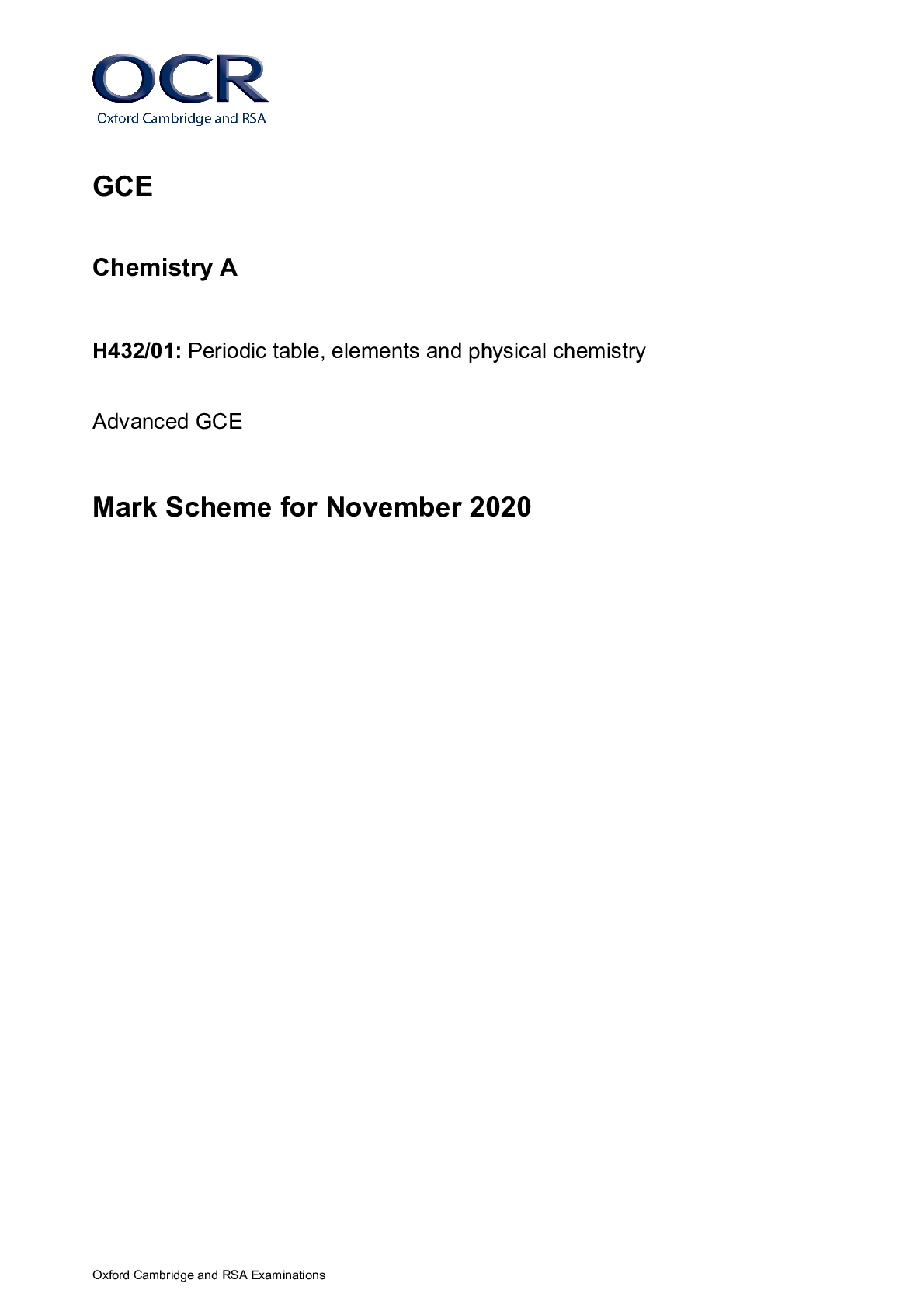
Buy this document to get the full access instantly
Instant Download Access after purchase
Buy NowInstant download
We Accept:

Reviews( 0 )
$6.00
Can't find what you want? Try our AI powered Search
Document information
Connected school, study & course
About the document
Uploaded On
Oct 07, 2022
Number of pages
25
Written in
Additional information
This document has been written for:
Uploaded
Oct 07, 2022
Downloads
0
Views
173

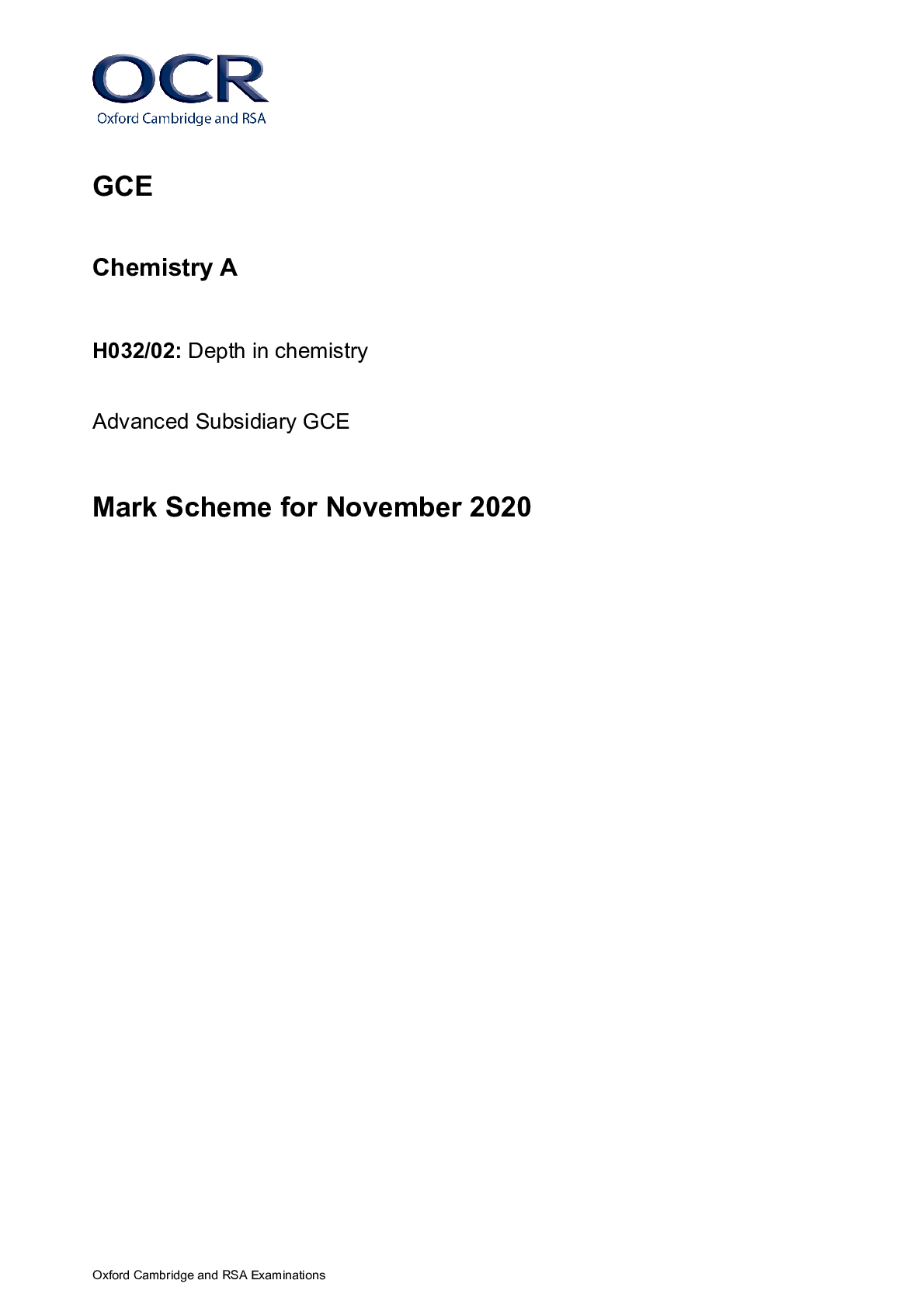

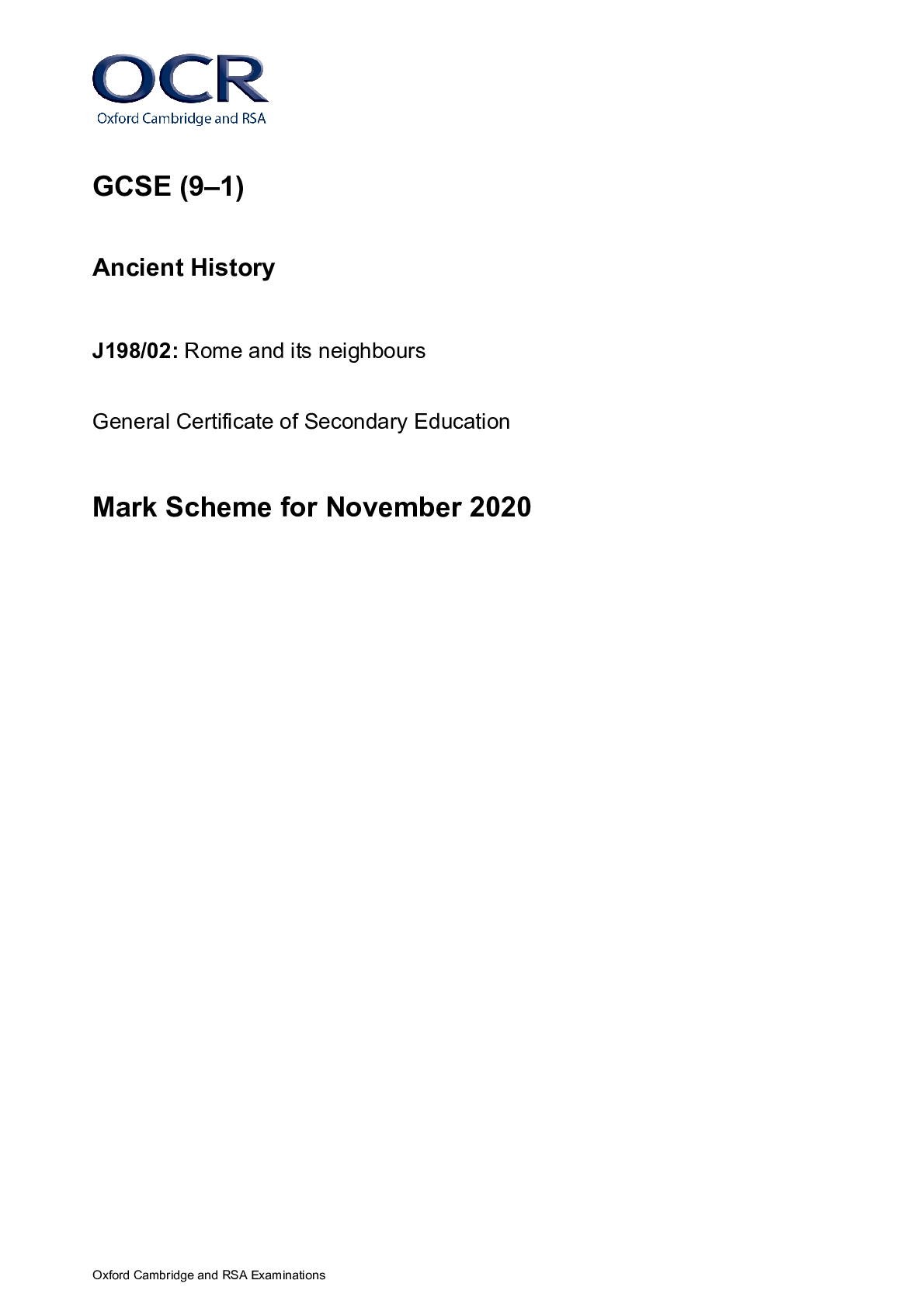




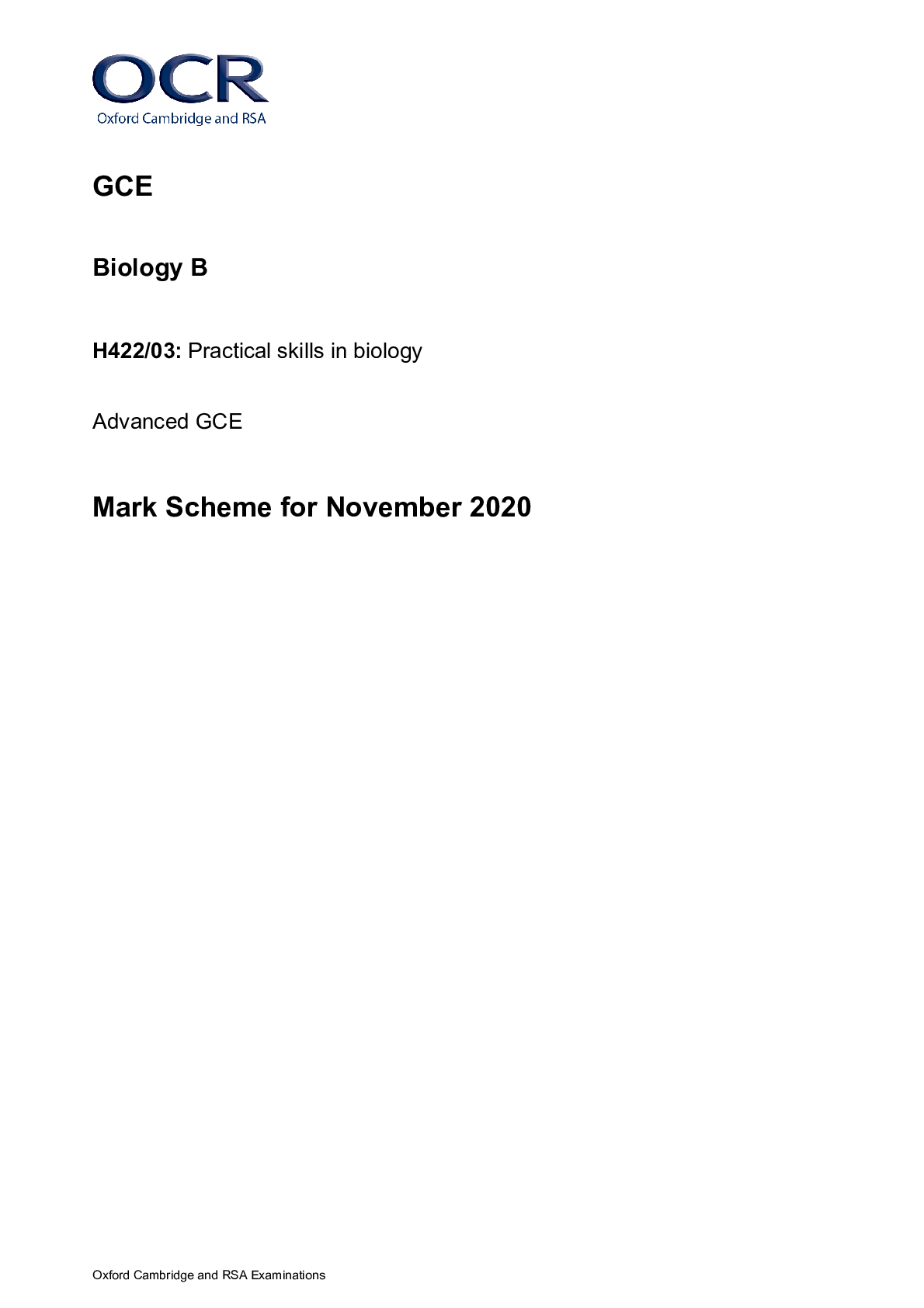

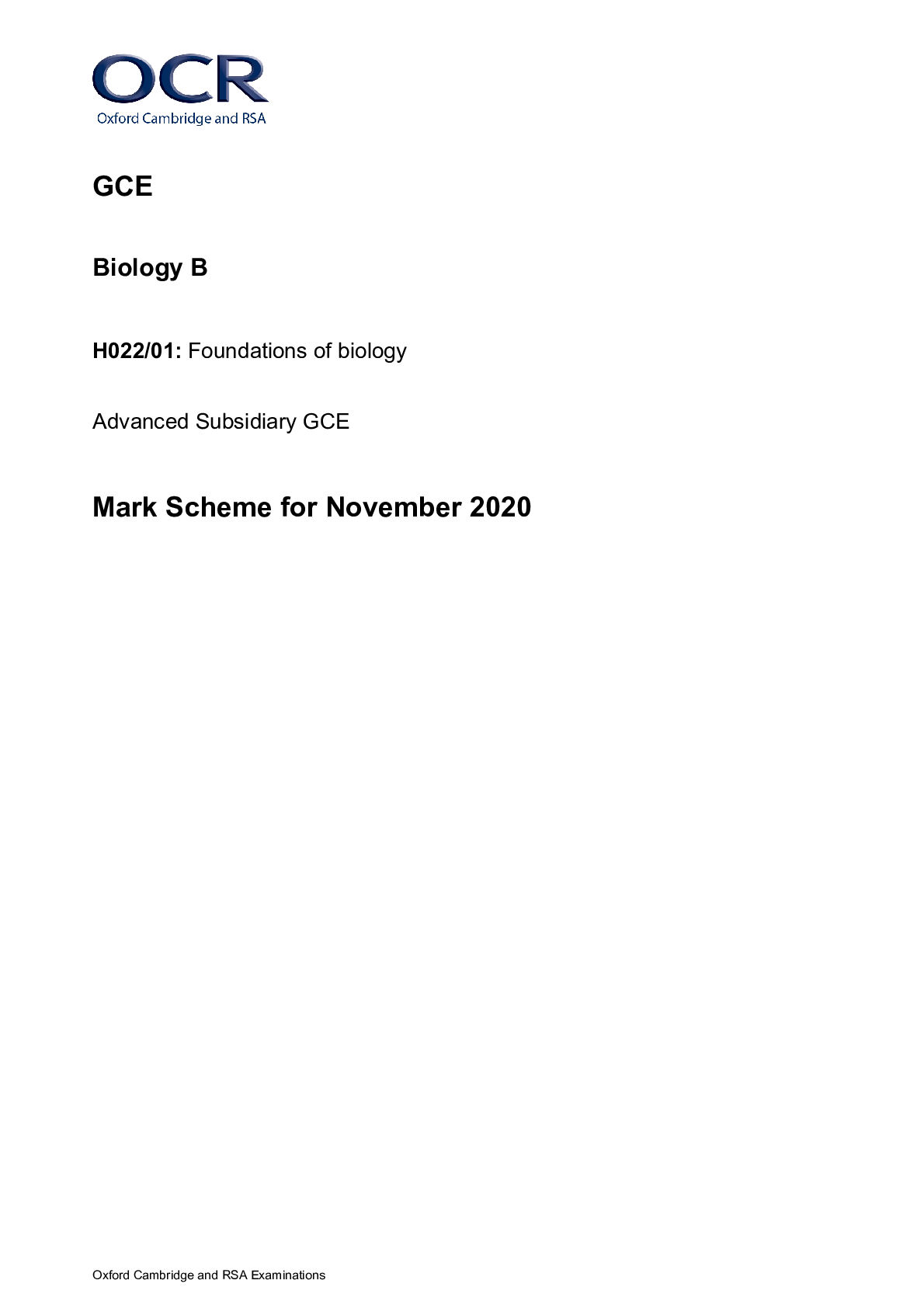



.png)
H630-02 Pure Mathematics and Statistics Advanced Subsidiary GCE Mark Scheme for Autumn 2021.png)





